- Runcinated 24-cell
-
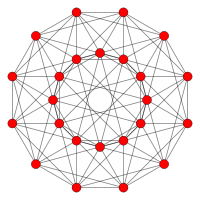
24-cell







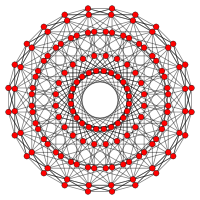
Runcinated 24-cell







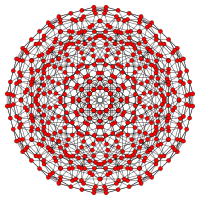
Runcitruncated 24-cell








Omnitruncated 24-cell
(Runcicantitruncated 24-cell)







Orthogonal projections in F4 Coxeter plane In four-dimensional geometry, a runcinated 24-cell is a convex uniform polychoron, being a runcination (a 3rd order truncation) of the regular 24-cell.
There are 3 unique degrees of runcinations of the 24-cell including with permutations truncations and cantellations.
Contents
Runcinated 24-cell
Runcinated 24-cell Type Uniform polychoron Schläfli symbol t0,3{3,4,3} Coxeter-Dynkin diagram 






Cells 240 48 3.3.3.3 
192 3.4.4
Faces 672 384{3}
288{4}Edges 576 Vertices 144 Vertex figure 
elongated square antiprismSymmetry group F4, [[3,4,3]], order 2304 Properties convex, edge-transitive Uniform index 25 26 27 In geometry, the runcinated 24-cell is a uniform polychoron bounded by 48 octahedra and 192 triangular prisms. The octahedral cells correspond with the cells of a 24-cell and its dual.
Coordinates
The Cartesian coordinates of the runcinated 24-cell having edge length 2 is given by all permutations of sign and coordinates of:
- (0, 0, √2, 2+√2)
- (1, 1, 1+√2, 1+√2)
The permutations of the second set of coordinates coincide with the vertices of an inscribed cantellated tesseract.
Projections
orthographic projections Coxeter plane F4 B4 Graph 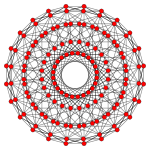
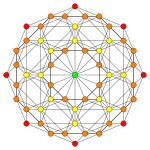
Dihedral symmetry [[12]] [8] Coxeter plane B3 / A2 B2 / A3 Graph 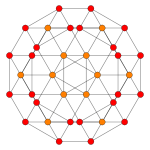

Dihedral symmetry [6] [[4]] 3D perspective projections 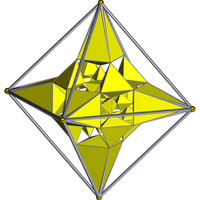
Schlegel diagram, centered on octahedron, with the octahedra shown.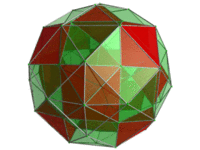
Perspective projection of the runcinated 24-cell into 3 dimensions, centered on an octahedral cell.The rotation is only of the 3D image, in order to show its structure, not a rotation in 4-space. Fifteen of the octahedral cells facing the 4D viewpoint are shown here in red. The gaps between them are filled up by a framework of triangular prisms.

Stereographic projection with 24 of its 48 octahedral cellsRelated regular skew polyhedron
The regular skew polyhedron, {4,8|3}, exists in 4-space with 8 square around each vertex, in a zig-zagging nonplanar vertex figure. These square faces can be seen on the runcinated 24-cell, using all 576 edges and 288 vertices. The 384 triangular faces of the runcinated 24-cell can be seen as removed. The dual regular skew polyhedron, {8,3|3}, is similarly related to the octagonal faces of the bitruncated 24-cell.
Runcitruncated 24-cell
Runcitruncated 24-cell Type Uniform polychoron Schläfli symbol t0,1,3{3,4,3} Coxeter-Dynkin diagram 






Cells 240 24 4.6.6 
96 4.4.6
96 3.4.4
24 3.4.4.4
Faces 1104 192{3}
720{4}
192{6}Edges 1440 Vertices 576 Vertex figure 
Trapezoidal pyramidSymmetry group F4, [3,4,3] Properties convex Uniform index 28 29 30 The runcitruncated 24-cell is a uniform polychoron derived from the 24-cell. It is bounded by 24 truncated octahedra, corresponding with the cells of a 24-cell, 24 rhombicuboctahedra, corresponding with the cells of the dual 24-cell, 96 triangular prisms, and 96 hexagonal prisms.
Coordinates
The Cartesian coordinates of an origin-centered runcitruncated 24-cell having edge length 2 are given by all permutations of coordinates and sign of:
- (0, √2, 2√2, 2+3√2)
- (1, 1+√2, 1+2√2, 1+3√2)
The permutations of the second set of coordinates give the vertices of an inscribed omnitruncated tesseract.
The dual configuration has coordinates generated from all permutations and signs of:
- (1,1,1+√2,5+√2)
- (1,3,3+√2,3+√2)
- (2,2,2+√2,4+√2)
Projections
orthographic projections Coxeter plane F4 Graph 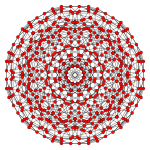
Dihedral symmetry [12] Coxeter plane B3 / A2 (a) B3 / A2 (b) Graph 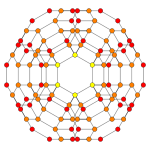
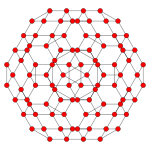
Dihedral symmetry [6] [6] Coxeter plane B4 B2 / A2 Graph 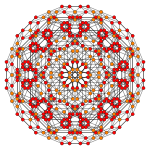
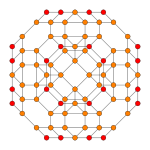
Dihedral symmetry [8] [4] 
Schlegel diagram
centered on rhombicuboctahedron
only triangular prisms shownOmnitruncated 24-cell
Omnitruncated 24-cell Type Uniform polychoron Schläfli symbol t0,1,2,3{3,4,3} Coxeter-Dynkin diagram 






Cells 240 48 (4.6.8) 
192 (4.4.6)
Faces 1392 864{4}
384{6}
144{8}Edges 2304 Vertices 1152 Vertex figure 
Irreg. tetrahedronSymmetry group F4, [[3,4,3]], order 2304 Properties convex Uniform index 29 30 31 The omnitruncated 24-cell is a uniform polychoron derived from the 24-cell. It is composed of 1152 vertices, 2304 edges, and 1392 faces (864 squares, 384 hexagons, and 144 octagons). It has 240 cells: 48 great rhombicuboctahedra, 192 hexagonal prisms. Each vertex contains four cells in an irregular tetrahedral vertex figure: two hexagonal prisms, and two truncated cuboctahedra.
Structure
The 48 great rhombicuboctahedral cells are joined to each other via their octagonal faces. They can be grouped into two groups of 24 each, corresponding with the cells of a 24-cell and its dual. The gaps between them are filled in by a network of 192 hexagonal prisms, joined to each other via alternating square faces in alternating orientation, and to the great rhombicuboctahedra via their hexagonal faces and remaining square faces.
Coordinates
The Cartesian coordinates of an omnitruncated 24-cell having edge length 2 are all permutations of coordinates and sign of:
- (1, 1+√2, 1+2√2, 5+3√2)
- (1, 3+√2, 3+2√2, 3+3√2)
- (2, 2+√2, 2+2√2, 4+3√2)
Projections
orthographic projections Coxeter plane F4 B4 Graph 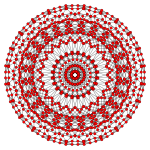
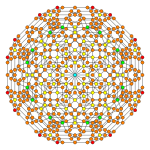
Dihedral symmetry [[12]] [8] Coxeter plane B3 / A2 B2 / A3 Graph 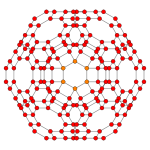
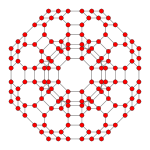
Dihedral symmetry [6] [[4]] 3D perspective projections 
Schlegel diagram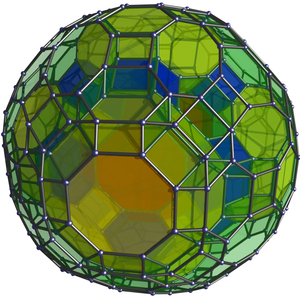
Perspective projection into 3D centered on a great rhombicuboctahedron. The nearest great rhombicuboctahedral cell to the 4D viewpoint is shown in red, with the six surrounding great rhombicuboctahedra in yellow. Twelve of the hexagonal prisms sharing a square face with the nearest cell and hexagonal faces with the yellow cells are shown in blue. The remaining cells are shown in green. Cells lying on the far side of the polytope from the 4D viewpoint have been culled for clarity.Related polytopes
Name 24-cell truncated 24-cell rectified 24-cell cantellated 24-cell bitruncated 24-cell cantitruncated 24-cell runcinated 24-cell runcitruncated 24-cell omnitruncated 24-cell snub 24-cell Schläfli
symbol{3,4,3} t0,1{3,4,3} t1{3,4,3} t0,2{3,4,3} t1,2{3,4,3} t0,1,2{3,4,3} t0,3{3,4,3} t0,1,3{3,4,3} t0,1,2,3{3,4,3} h0,1{3,4,3} Coxeter-Dynkin
diagram





































































Schlegel
diagram









F4 









B4 









B3(a) 









B3(b) 





B2 









References
- Kaleidoscopes: Selected Writings of H.S.M. Coxeter, editied by F. Arthur Sherk, Peter McMullen, Anthony C. Thompson, Asia Ivic Weiss, Wiley-Interscience Publication, 1995, ISBN 978-0-471-01003-6 [1]
- (Paper 22) H.S.M. Coxeter, Regular and Semi-Regular Polytopes I, [Math. Zeit. 46 (1940) 380-407, MR 2,10]
- (Paper 23) H.S.M. Coxeter, Regular and Semi-Regular Polytopes II, [Math. Zeit. 188 (1985) 559-591]
- (Paper 24) H.S.M. Coxeter, Regular and Semi-Regular Polytopes III, [Math. Zeit. 200 (1988) 3-45]
- J.H. Conway and M.J.T. Guy: Four-Dimensional Archimedean Polytopes, Proceedings of the Colloquium on Convexity at Copenhagen, page 38 und 39, 1965
- N.W. Johnson: The Theory of Uniform Polytopes and Honeycombs, Ph.D. Dissertation, University of Toronto, 1966
- Four-dimensional Archimedean Polytopes (German), Marco Möller, 2004 PhD dissertation [2] m58 m59 m53
- 3. Convex uniform polychora based on the icositetrachoron (24-cell), George Olshevsky.
- Richard Klitzing, 4D, uniform polytopes (polychora) x3o4o3x - spic, x3x4o3x - prico, x3x4x3x - gippic
Fundamental convex regular and uniform polytopes in dimensions 2–10 Family An BCn Dn E6 / E7 / E8 / F4 / G2 Hn Regular polygon Triangle Square Hexagon Pentagon Uniform polyhedron Tetrahedron Octahedron • Cube Demicube Dodecahedron • Icosahedron Uniform polychoron 5-cell 16-cell • Tesseract Demitesseract 24-cell 120-cell • 600-cell Uniform 5-polytope 5-simplex 5-orthoplex • 5-cube 5-demicube Uniform 6-polytope 6-simplex 6-orthoplex • 6-cube 6-demicube 122 • 221 Uniform 7-polytope 7-simplex 7-orthoplex • 7-cube 7-demicube 132 • 231 • 321 Uniform 8-polytope 8-simplex 8-orthoplex • 8-cube 8-demicube 142 • 241 • 421 Uniform 9-polytope 9-simplex 9-orthoplex • 9-cube 9-demicube Uniform 10-polytope 10-simplex 10-orthoplex • 10-cube 10-demicube n-polytopes n-simplex n-orthoplex • n-cube n-demicube 1k2 • 2k1 • k21 pentagonal polytope Topics: Polytope families • Regular polytope • List of regular polytopes Categories:- Four-dimensional geometry
- Polychora
Wikimedia Foundation. 2010.
